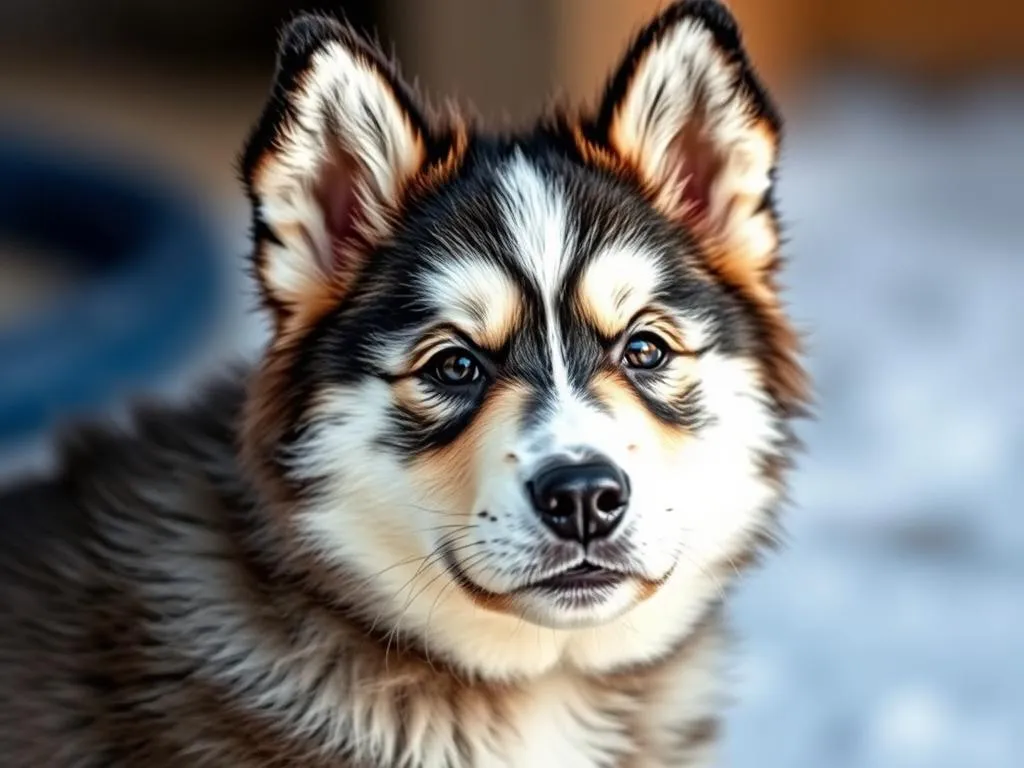
Introduction
Dog breeds are an essential aspect of canine diversity, representing various traits, behaviors, and appearances that cater to different lifestyles and needs. Each breed has unique characteristics shaped by generations of selective breeding, influencing their temperament, health, and physical attributes.
As we explore the fascinating world of dog breeds, we encounter the rise of hybrid breeds—dogs that result from crossing two distinct purebred breeds. This trend has gained traction among dog enthusiasts and families alike, as hybrid breeds often combine the best traits from their parent breeds.
One such hybrid that has captured the hearts of many is the Huskydoodle. This delightful mix of the Siberian Husky and the Poodle boasts a charming personality, striking looks, and a loving nature. In this article, we will delve into the intricacies of the Huskydoodle, providing insights into its origin, characteristics, care requirements, and much more.
Understanding Dog Breeds
What is a Dog Breed?
A dog breed is a specific group of domestic dogs with shared characteristics, including physical appearance, behavior, and genetic lineage. Breeds are categorized based on various factors, such as size, purpose, and temperament. They serve as a means for potential dog owners to select a pet that aligns with their lifestyle and preferences.
Importance of Breeds
The significance of breeds extends beyond mere aesthetics. Different breeds possess unique temperaments and behaviors influenced by their lineage. For instance, working dogs often exhibit strong instincts for tasks such as herding or guarding, while toy breeds tend to be more suited for companionship. Understanding these differences is crucial for choosing a dog that fits seamlessly into one’s home and family.
Popular Dog Breed Categories
Dog breeds can be classified into several categories, including:
- Working Dogs: Bred for specific tasks like guarding, pulling sleds, or search and rescue. Examples include the Rottweiler and Boxer.
- Sporting Dogs: Active and energetic breeds designed for hunting and retrieving. Breeds like the Labrador Retriever and Golden Retriever fall into this category.
- Hound Dogs: Known for their keen sense of smell and tracking abilities, such as Beagles and Bloodhounds.
- Toy Dogs: Smaller breeds that are often kept as companions, including Chihuahuas and Pomeranians.
- Terriers: Energetic and tenacious dogs originally bred for hunting vermin, like the Jack Russell Terrier.
Introduction to Hybrid Breeds
Definition of Hybrid Breeds
Hybrid breeds result from the intentional crossbreeding of two purebred dogs. This practice aims to combine desirable traits from both parents, resulting in a unique mix that often benefits from hybrid vigor—a phenomenon where crossbred animals exhibit improved health and vitality compared to their purebred counterparts.
Benefits of Hybrid Breeds
The appeal of hybrid breeds lies in their potential advantages:
- Health Improvements: Many hybrids are less prone to the genetic health issues that can affect purebred dogs. This is often due to the diverse gene pool offered by crossbreeding.
- Variety in Traits: Hybrid breeds can exhibit a mix of the physical and behavioral characteristics of their parent breeds, allowing prospective owners to find a dog that meets their specific needs.
- Combining Desirable Traits: Many hybrids are bred intentionally to combine traits like intelligence, temperament, and appearance, resulting in dogs that are not only beautiful but also well-suited for family life.
Overview of Popular Hybrid Breeds
Several hybrid breeds have gained popularity in recent years, including:
- Labradoodle: A mix of Labrador Retriever and Poodle, known for its friendly demeanor and hypoallergenic coat.
- Goldendoodle: A cross between a Golden Retriever and a Poodle, celebrated for its intelligence and loving nature.
- Cockapoo: A delightful mix of Cocker Spaniel and Poodle, recognized for its affectionate temperament and adaptability.
The Huskydoodle: An In-Depth Look
Origin of the Huskydoodle
The Huskydoodle is a relatively new hybrid breed, emerging from the combination of the intelligent Poodle and the spirited Siberian Husky. The hybrid was developed to create a dog that possesses the loyalty and playful nature of the Husky while benefiting from the Poodle’s hypoallergenic qualities and trainability. The exact timeline of the Huskydoodle‘s development remains unclear, but its popularity has soared in recent years.
Physical Characteristics
Huskydoodles can vary widely in size and appearance, largely influenced by their parent breeds. Typically, they range from medium to large, standing between 18 to 24 inches tall at the shoulder. Their weight can vary from 30 to 65 pounds, depending on the size of the Poodle parent.
Coat types can also differ, with some Huskydoodles sporting a wavy, curly coat inherited from the Poodle, while others may have a straighter, thicker coat reminiscent of the Husky. Colors can range from solid black, white, and brown to various combinations and patterns, making each Huskydoodle unique.
Temperament and Behavior
The Huskydoodle is known for its friendly and outgoing nature. They are typically intelligent, eager to please, and highly trainable, thanks to their Poodle lineage. Their Husky heritage contributes to a playful disposition, making them excellent companions for active families.
With a moderate to high energy level, Huskydoodles require regular exercise and mental stimulation. They thrive in environments where they can play, run, and explore. Their friendly demeanor often makes them good with children and other pets, though early socialization is crucial in shaping their behavior.
Health Considerations
Like all breeds, Huskydoodles may be prone to certain health issues. Common concerns include hip dysplasia, eye conditions, and skin allergies. Regular veterinary check-ups, a balanced diet, and proper exercise can help mitigate these risks. The average lifespan of a Huskydoodle is typically between 10 to 15 years, depending on genetics and overall care.
Caring for a Huskydoodle
Diet and Nutrition
Providing a balanced diet is vital for the health and well-being of your Huskydoodle. High-quality dog food formulated for their size and energy level is recommended. Feeding schedules should be consistent, with adult dogs typically requiring two meals a day. Portion control is essential to prevent obesity, as both parent breeds can be prone to weight gain.
Exercise Requirements
Huskydoodles are active dogs that require daily exercise to maintain their physical and mental health. A combination of walks, playtime, and interactive games will keep them engaged and prevent boredom. Activities like fetching, agility training, and even swimming can be great outlets for their energy.
Grooming Needs
Grooming is an essential aspect of caring for a Huskydoodle. Depending on their coat type, they may require regular brushing to prevent matting and reduce shedding. For those with curlier coats, grooming might need to occur every few weeks. Bathing should be done as needed, and regular nail trimming is crucial to maintain their comfort and mobility.
Training and Socialization
Early training and socialization are critical for a well-adjusted Huskydoodle. They respond well to positive reinforcement techniques, such as treats and praise. Basic obedience training should begin as soon as you bring your puppy home, focusing on commands like sit, stay, and come.
Socialization with other dogs, pets, and people is also vital to help them develop confidence and reduce anxiety in new situations. Puppy classes can be a great way to meet other dogs and learn essential skills.
Living with a Huskydoodle
Best Living Environments
Huskydoodles adapt well to various living environments, but they thrive in homes with ample space for play and exercise. They can live comfortably in both apartments and houses, provided they receive daily exercise. A fenced yard is ideal, allowing them to roam freely while ensuring their safety.
Compatibility with Children and Other Pets
Generally, Huskydoodles are friendly and sociable, making them great companions for families with children. Their playful nature often leads to strong bonds with kids, but supervision during playtime is essential to ensure safety for both parties.
When introducing a Huskydoodle to other pets, gradual introductions and positive reinforcement can help foster harmonious relationships. Early socialization will aid in reducing any territorial or aggressive behaviors.
Traveling with a Huskydoodle
Traveling with a Huskydoodle can be a rewarding experience, as they often enjoy new adventures. Crate training can help them feel secure while traveling, and it’s essential to ensure they have access to fresh water and breaks during long journeys. Familiarizing them with various environments can ease the transition and reduce anxiety.
Frequently Asked Questions (FAQs)
What is the average lifespan of a Huskydoodle?
The average lifespan of a Huskydoodle is typically between 10 to 15 years, depending on their genetics, health, and care.
Are Huskydoodles hypoallergenic?
While Huskydoodles may inherit the hypoallergenic coat of their Poodle parent, it’s essential to note that no dog is entirely hypoallergenic. However, they tend to shed less, making them a suitable option for individuals with allergies.
How much do Huskydoodles typically cost?
The price of a Huskydoodle can vary significantly based on factors like breeder reputation, location, and demand. On average, they can range from $1,000 to $3,000.
What are the common behavioral issues with Huskydoodles?
Some common behavioral issues that may arise include separation anxiety, excessive barking, and stubbornness if not properly trained and socialized. Consistent training and mental stimulation can help alleviate these behaviors.
Can Huskydoodles be left alone for long periods?
Huskydoodles thrive on companionship and can experience separation anxiety if left alone for extended periods. Ideally, they should not be left alone for more than four to six hours a day. If long absences are unavoidable, consider hiring a dog walker or utilizing pet daycare services.
Conclusion
In summary, the Huskydoodle is a delightful hybrid breed that combines the best traits of the Siberian Husky and Poodle. With their unique appearance, friendly temperament, and intelligence, they make excellent companions for families and individuals alike.
Understanding the characteristics, care requirements, and living preferences of a Huskydoodle is crucial for ensuring a fulfilling relationship. With proper training, socialization, and love, a Huskydoodle can bring joy and companionship to any home.
Choosing to welcome a Huskydoodle into your life could lead to a rewarding experience filled with love, laughter, and adventure. Whether you’re a first-time dog owner or an experienced handler, the Huskydoodle is sure to steal your heart.









